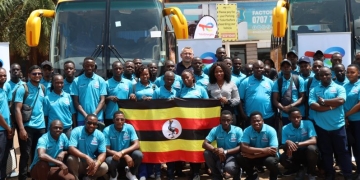
Kilembe Mines, located at the base of the Rwenzori Mountains in Western Uganda, has a storied past as a key player in the region’s economic landscape. Founded in the 1950s, this copper and cobalt mine once served as a cornerstone of Uganda’s industrial development, providing employment opportunities and driving infrastructure improvements in the area.
The mine’s contribution to Uganda’s economy was significant, particularly during its peak production years when it was producing tens of thousands of tons of copper annually. Yet, alongside these economic benefits, the mines have also contributed to a host of environmental challenges that have shaped the livelihoods and health of surrounding communities and disrupted local ecosystems.
The history of Kilembe Mines stretches back to a time of colonial rule when foreign investors first sought to tap into the area’s mineral wealth.
The mine experienced steady growth in the decades following its establishment, with a thriving workforce and growing output. However, in the 1970s, amid political instability and economic turmoil, the operations at Kilembe began to falter.
Production rates declined, and by the late 1980s, the mine had effectively closed, leaving behind an environmental legacy that continues to resonate to this day. In recent years, attempts to revive the mine have surfaced; in 2013, the Ugandan government signed a memorandum with a private investor, sparking hopes for a return to mining activity.
Despite these efforts, concerns about the ecological degradation associated with Kilembe remain pressing, highlighting the complex relationship between economic growth and environmental stewardship.
The environmental impacts of Kilembe Mines are multifaceted, stemming from decades of heavy mining activity and limited environmental oversight. Soil contamination is a prominent issue, with mining activities introducing heavy metals and other contaminants into the soil, posing significant risks to agriculture and, by extension, food security.
These pollutants, remnants of previous mining processes, have permeated the soil in the region, reducing its fertility and exposing local communities to health risks through their food supply. Water pollution is also a pressing concern. Rivers and streams near Kilembe have been exposed to mining waste runoff, resulting in elevated levels of toxic metals in the water.
These contaminants threaten aquatic life and reduce the availability of safe drinking water for local populations that rely on these water sources for daily needs.
Air quality has likewise been compromised due to mining practices. The extraction and processing of minerals release particulate matter and other pollutants into the atmosphere, creating a health hazard for communities living in the mine’s vicinity.
Dust from mining operations carries potentially harmful particles that can cause respiratory issues in residents, especially children and the elderly. In addition to the immediate health risks, this air pollution can also impact the region’s vegetation, causing broader ecological effects that ripple through the local ecosystem. Biodiversity in the Kilembe region has also been significantly affected.
Mining has led to habitat destruction, threatening the survival of various plant and animal species native to the area. The loss of natural habitats has placed pressure on endangered species, some of which are unique to the Rwenzori region. The ecological disturbances from mining activities risk upsetting the balance of the local environment, reducing biodiversity and weakening the resilience of ecosystems to environmental changes.
The impact of these environmental challenges on local communities is profound. In areas surrounding Kilembe, residents have reported health issues that they attribute to pollution from the mines. Cases of respiratory illnesses, skin conditions, and other health problems are common among those living near the former mining site. Economic hardships are also widespread, as soil contamination affects crop yields and reduces agricultural productivity.
Many residents rely on farming as their primary livelihood, and diminished soil quality directly translates to lower incomes and increased food insecurity. Stories of community members facing these hardships illustrate the lasting impact of Kilembe Mines on everyday life, highlighting the need for effective responses and remediation efforts.
The regulatory framework governing mining operations in Uganda has attempted to address these environmental challenges, though with limited success. While Uganda has laws in place to regulate environmental practices in the mining sector, enforcement remains inconsistent. Environmental Impact Assessments (EIAs) are required by law for new mining projects, but historical sites like Kilembe often fall through the cracks in regulatory oversight.
The legacy impacts from past mining activities have not been sufficiently addressed, underscoring the limitations of current policies in tackling long-standing environmental degradation. Community advocacy has emerged as a powerful response to the issues stemming from Kilembe Mines. Grassroots movements and non-governmental organizations have taken up the cause, pushing for accountability and environmental justice. These groups have raised awareness about the dangers of unregulated mining practices and lobbied for stricter enforcement of environmental regulations. Some local communities have also initiated projects aimed at rehabilitating degraded land, planting trees, and promoting sustainable practices to mitigate the damage caused by mining.
Looking forward, there are various strategies that could help mitigate the environmental impact of Kilembe Mines. Reclamation of contaminated soils and water bodies, through techniques such as phytoremediation, could help restore ecosystems and improve public health. Reforestation and biodiversity conservation initiatives are also crucial in rebuilding habitats for endangered species. Sustainable mining practices, if Kilembe is reopened, would be essential to minimize future environmental damage. Key stakeholders, including the Ugandan government, private investors, and local communities, must collaborate to prioritize environmental health and sustainability, balancing the region’s economic interests with a commitment to responsible environmental management.
The writer, Hellen Masika is a Community Mobilizer at Centre for Citizens Conserving Environment & Management (CECIC)










Discussion about this post